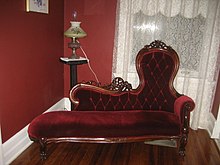Fainting couch

Méridienne (c. 1750-1760).

Red upholstered fainting couch.
A fainting couch is a term said to have been used for a couch with a back that is traditionally raised at one end. The back may be situated completely at one side of the couch, or may wrap around and extend the entire length of the piece much like a traditional couch. However, so-called "fainting couches" are easily differentiated from more traditional couches, having one end of the back raised.[1]
The style of couch referred to popularly as "fainting couches" were popular in the 19th century as a revival of ancient furniture styles.[1]
Some people today[who?] believe that houses would take this to the level of having separate fainting rooms, where these couches would be the featured furniture[citation needed].
Popular speculation about the need for fainting couches[]
- The term "fainting couch" is not documented as being in use until the 20th century. There is nothing to suggest in advertising of the Victorian era that any article of furniture was created specifically for people to use when feeling faint and should only be considered a myth.[1]
- Corsets: One theory for the predominance of what are now called "fainting couches" is that women were actually fainting because their corsets were too tight, restricting blood flow. However, pictures from the 1860s show women horseback riding, playing tennis, and engaging in other vigorous activities in corsets without hindrance.[2][3]
- Female hysteria: Another theory for their predominance is that the treatment of hysteria through manual pelvic massage by home visiting doctors and midwives[4] required regular, typically weekly, in-home treatment that could sometimes take hours. Creating specialized furniture for maximum comfort during the extended procedure seems likely, as does the later creation of fainting rooms for privacy.
See also[]
References[]
- ^ a b c "New York Times".
- ^ https://www.lancasterhistory.org/debunkingcorsetrymyths/
- ^ August 8; Comments, 2016 | 7. "Victorian Sportswear: Tennis Fashions of the Late 19th Century". Mimi Matthews. Retrieved 2021-05-18.CS1 maint: numeric names: authors list (link)
- ^ Rachel P. Maines (1999). The Technology of Orgasm: "Hysteria", the Vibrator, and Women's Sexual Satisfaction. Baltimore: The Johns Hopkins University Press. ISBN 0-8018-6646-4.
Further reading[]
- John Gloag, A Short Dictionary of Furniture, rev. ed. 1962. (London: Allen & Unwin).
- Ellis-Christensen, T., & Wallace, O. (2014, July 7). . WiseGeek. Retrieved July 15, 2014, from http://www.wisegeek.com/what-is-a-fainting-couch.htm
External links[]
 Media related to Fainting couches at Wikimedia Commons
Media related to Fainting couches at Wikimedia Commons
Categories:
- Couches